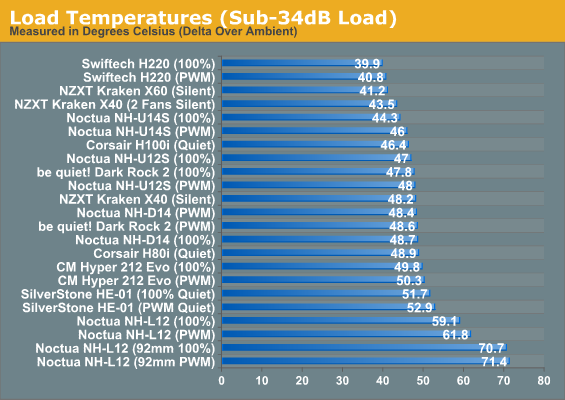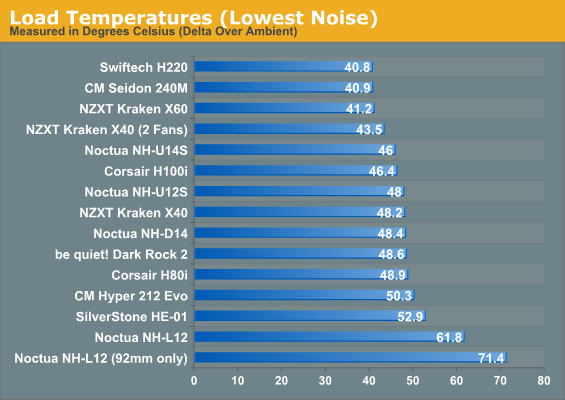Cooler Master Seidon 240M and 12 More Coolers: The Retest and Mega-Roundup
by Dustin Sklavos on April 26, 2013 6:01 AM ESTSilent Running Performance
There was a tremendous amount of data on the previous page; we need to make it easier and condense it into more readily useful information. So we'll start by culling all of the test results where the coolers had to run at higher than 34dB, leaving us with a healthy cross-section of quieter cooling solutions.

This is where Swiftech makes their move. The H220 offers essentially the best low noise performance out of all of the coolers we've tested. Unfortunately, load noise takes the Cooler Master Seidon 240M out of the equation at any level; even with PWM enabled, the 240M went up to 38dB.
You'll also notice that while the top four positions are held by closed loop coolers, air cooling essentially makes its comeback here as a quieter solution overall. The air coolers we've tested are all, outside of SilverStone's HE-01, designed to be silent, so this isn't a surprise. The surprise is more that closed loop coolers running at quiet settings are having a much harder time competing.

Culling all of our data down to the lowest noise settings is even more interesting. Swiftech's H220 continues to do well, but the Seidon 240M sort of cheats: this may be its quietest, but it's still running at 38dB, 5dB higher than the more expensive H220. The NZXT Kraken X40 turns out to do much better in a push-pull configuration, though, and its noise level is just 31.2dB, 2dB quieter than the H220 in exchange for running about 2-3C warmer. The second fan turns the Kraken X40 into a dark horse contender and brings it into the overall conversation; adding the second fan doesn't actually increase load noise at the Kraken's silent setting, but it does bring thermals down by a healthy 5C.










62 Comments
View All Comments
DanNeely - Friday, April 26, 2013 - link
In the last test it was 6C hotter than the worst cooler in this review. That would put the core temp in the high 90s and possibly result in thermal throttling.http://www.anandtech.com/show/6830/cpu-air-cooler-...
tsponholz - Friday, April 26, 2013 - link
It would be nice to see this a baseline.Hrel - Friday, April 26, 2013 - link
agreed, just mention the numbers outside of the graph, so it doesn't fuck up the comparative look.Torrijos - Friday, April 26, 2013 - link
It's a little sad not to have the H110 on that test since it tends to be quieter than the X60 for the same level of performance.JustMoreFun - Friday, April 26, 2013 - link
It's very sad that you up to now didn't test one of the Thermalright Coolers, as they are commonly referred to as being the reference when it comes to air coolers.davidthemaster30 - Friday, April 26, 2013 - link
If the NH-U14S, was mounted so that it pushed air towards the top of the case, would it still block the PCIe slot?marc1000 - Friday, April 26, 2013 - link
I don't believe it would fit inside the case in this position... it looks like it would go past the backplate.epoon2 - Friday, April 26, 2013 - link
You should check with Noctua, they have an FAQ listing motherboard compatibilityspidey81 - Friday, April 26, 2013 - link
First I'd like to say that I thoroughly enjoy your articles. In your recommendation of the U12S/U14S over the D14 I think you may have missed something. At your current 4.4 Ghz overclock the smaller/cheaper heatsinks performed, let's say, more efficiently. However, wouldn't the D14 be able to handle a higher thermal load that come with higher overclocks? So it's kind of like you said, it depends on your usage. It would be interesting to see at what point in overclocking would the D14 become worth purchasing over it's smaller siblings.epoon2 - Friday, April 26, 2013 - link
it scales in the same direction for all coolers as temperature increases, common sense or wrong?